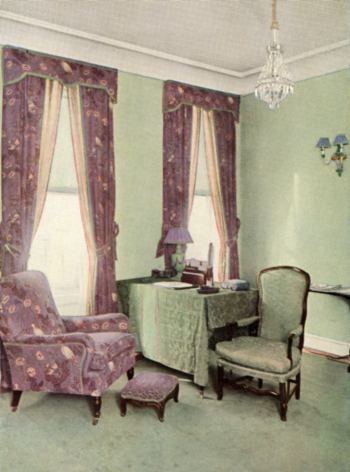
In The House in Good Taste Elsie argued for plainer, brighter, simpler, yet more refined homes. She advocated the use of softer wall and woodwork colors than perhaps had been popular in the years proceeding; the use of bright chintzes for curtains and upholestry of furniture; the use of furniture in Colonial and European (particularly French) styles, as well as painted and stenciled furniture; plenty of electric, candle, and gas lights; and the use of porcelain bowls, flowers, and other knick-knacks to enhance the rooms. She liked the items in a room to complement one another, but did not think that everything to match; she even said that you did not have to have a matching set of dining-room chairs!
Many of her suggestions were practical and not hugely expensive to carry out (despite the fact that many of her clients were millionaires). She included a chapter on decorating small apartments, and discussed her experience of decorating her various homes in the United States and Europe. (In her chapter on her Villa Trianon in Versailles, France, she was careful to note that they had bargained to get the villa at a price she could afford.)
She liked to use paint on the walls unless the plaster was in bad shape and you needed to cover it with wallpaper (a view I tend to share). She sanctioned the use of reproduction furniture, rather than only antiques, believing that a good reproduction was better than a feeble original.
She also included a chapter on her gardening aesthetic, and information on her use of trelliswork inside and outside.
Elsie de Wolfe's influence continues into the present. Mention is still found upon occasion in contemporary magazines. Elsie may have also influenced my Grandmother's style of interior decorating.

A room designed by Elsie de Wolfe. The mauve and pale green is an unusual combination rarely seen today, but Elsie liked to combine greens, purples, and lavenders. (Another color scheme that she liked was blue, rose, and cream.) The room features many of Elsie's favorite things: a writing desk, abundant light sources (chandelier, lamp on desk, and sconce on wall), seating situated for ease of conversation, a stool for putting ones' feet up on (or for someone to sit on), and chintz curtains.
Black and white photograph of Elsie de Wolfe from Elsie de Wolfe, The House in Good Taste, The Century Company, 1913. Color photograph from same source, but credited to Butterick Publishing Co., 1911, 1912.
Copyright © 2004, 2009 Sarah E. Mitchell